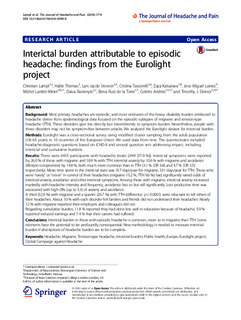| dc.contributor.author | Lampl, Christian | |
| dc.contributor.author | Thomas, Hallie | |
| dc.contributor.author | Stovner, Lars Jacob | |
| dc.contributor.author | Tassorelli, Cristina | |
| dc.contributor.author | Katsarava, Zaza | |
| dc.contributor.author | Laínez, Jose Miguel | |
| dc.contributor.author | Lantéri-Minet, Michel | |
| dc.contributor.author | Rastenyte, Daiva | |
| dc.contributor.author | Ruiz de la Torre, Elena | |
| dc.contributor.author | Andrée, Colette | |
| dc.contributor.author | Steiner, Timothy J. | |
| dc.date.accessioned | 2018-11-23T12:13:47Z | |
| dc.date.available | 2018-11-23T12:13:47Z | |
| dc.date.created | 2016-08-11T12:12:53Z | |
| dc.date.issued | 2016 | |
| dc.identifier.citation | The Journal of Headache and Pain. 2016, 17:9 . | nb_NO |
| dc.identifier.issn | 1129-2369 | |
| dc.identifier.uri | http://hdl.handle.net/11250/2574578 | |
| dc.description.abstract | Background
Most primary headaches are episodic, and most estimates of the heavy disability burden attributed to headache derive from epidemiological data focused on the episodic subtypes of migraine and tension-type headache (TTH). These disorders give rise directly but intermittently to symptom burden. Nevertheless, people with these disorders may not be symptom-free between attacks. We analysed the Eurolight dataset for interictal burden.
Methods
Eurolight was a cross-sectional survey using modified cluster sampling from the adult population (18–65 years) in 10 countries of the European Union. We used data from nine. The questionnaire included headache-diagnostic questions based on ICHD-II and several question sets addressing impact, including interictal and cumulative burdens.
Results
There were 6455 participants with headache (male 2444 [37.9 %]). Interictal symptoms were reported by 26.0 % of those with migraine and 18.9 % with TTH: interictal anxiety by 10.6 % with migraine and avoidance (lifestyle compromise) by 14.8 %, both much more common than in TTH (3.1 % [OR 3.8] and 4.7 % [OR 3.5] respectively). Mean time spent in the interictal state was 317 days/year for migraine, 331 days/year for TTH. Those who were “rarely” or “never” in control of their headaches (migraine 15.2 %, TTH 9.6 %) had significantly raised odds of interictal anxiety, avoidance and other interictal symptoms. Among those with migraine, interictal anxiety increased markedly with headache intensity and frequency, avoidance less so but still significantly. Lost productive time was associated with high ORs (up to 5.3) of anxiety and avoidance.
A third (32.9 %) with migraine and a quarter (26.7 %) with TTH (difference: p < 0.0001) were reluctant to tell others of their headaches. About 10 % with each disorder felt families and friends did not understand their headaches. Nearly 12 % with migraine reported their employers and colleagues did not.
Regarding cumulative burden, 11.8 % reported they had done less well in education because of headache, 5.9 % reported reduced earnings and 7.4 % that their careers had suffered.
Conclusions
Interictal burden in those with episodic headache is common, more so in migraine than TTH. Some elements have the potential to be profoundly consequential. New methodology is needed to measure interictal burden if descriptions of headache burden are to be complete. | nb_NO |
| dc.language.iso | eng | nb_NO |
| dc.publisher | BMC (part of Springer Nature) | nb_NO |
| dc.rights | Navngivelse 4.0 Internasjonal | * |
| dc.rights.uri | http://creativecommons.org/licenses/by/4.0/deed.no | * |
| dc.title | Interictal burden attributable to episodic headache: findings from the Eurolight project | nb_NO |
| dc.title.alternative | Interictal burden attributable to episodic headache: findings from the Eurolight project | nb_NO |
| dc.type | Journal article | nb_NO |
| dc.type | Peer reviewed | nb_NO |
| dc.description.version | publishedVersion | nb_NO |
| dc.source.pagenumber | 10 | nb_NO |
| dc.source.volume | 17:9 | nb_NO |
| dc.source.journal | The Journal of Headache and Pain | nb_NO |
| dc.identifier.doi | 10.1186/s10194-016-0599-8 | |
| dc.identifier.cristin | 1372123 | |
| dc.description.localcode | © Lampl et al. 2016. This article is distributed under the terms of the Creative Commons Attribution 4.0 International License (http://creativecommons.org/licenses/by/4.0/) | nb_NO |
| cristin.unitcode | 194,65,30,0 | |
| cristin.unitname | Institutt for nevromedisin og bevegelsesvitenskap | |
| cristin.ispublished | true | |
| cristin.fulltext | original | |
| cristin.qualitycode | 1 | |

